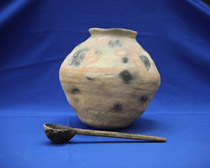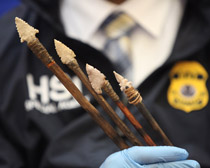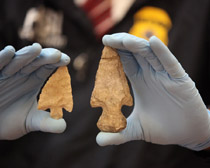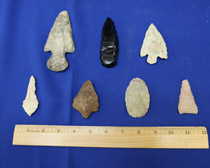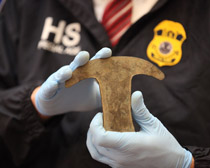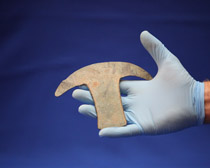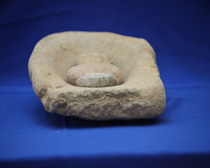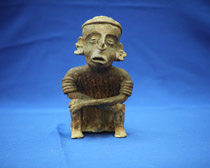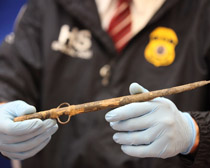Archived Content
In an effort to keep ICE.gov current, the archive contains content from a previous administration or is otherwise outdated. This information is archived and not reflective of current practice.
ICE returns stolen and looted archeological art and antiquities to Mexico
EL PASO, Texas — U.S. Immigration and Customs Enforcement (ICE) returned more than 4,000 pieces of stolen and looted cultural artifacts to the government of Mexico at a repatriation ceremony today at the Consulate of Mexico in El Paso, Texas.
The items were recovered in 11 separate investigations by special agents of ICE's Homeland Security Investigations (HSI) in Douglas, Ariz.; San Diego, Calif.; Chicago; Kalispell, Mont.; Alpine, Del Rio and Laredo, Texas; and one in Mexico City, in coordination with Mexican law enforcement agencies.
Among the archeological pieces returned to the people of Mexico are the following: five pre-Columbian statues, more than 4,000 pre-Columbian artifacts and 26 pieces of pre-Columbian pottery that date back more than 1,500 years. The return of this cultural property is the culmination of HSI undercover and sting operations with assistance from U.S. Customs and Border Protection (CBP), who interdicted many of these items at various ports of entry.
Participating in today's ceremony were: HSI Assistant Director of Domestic Operations Janice Ayala, Consul General of Mexico in El Paso Jacob Prado, HSI El Paso Acting Special Agent in Charge Dennis A. Ulrich, and the President of the Mexican Consejo de Arqueología del Instituto Nacional de Antropología e Historia, Dr. Pedro Francisco Sánchez. Also in attendance was HSI Ciudad Juarez Assistant Attaché Jaime Corona, representatives from Mexico's, Procuraduría General de la República, Secretaría de Relaciones Exteriores (SRE) and HSI special agents from their respective investigative offices.
"The plundering of cultural property is one of the oldest forms of organized cross-border crime and has become a worldwide phenomenon that transcends frontiers," said HSI Assistant Director Janice Ayala. "The teamwork and cooperation that exists between ICE's Homeland Security Investigations and our Mexican law enforcement counterparts, as well as with U.S. federal, local and state law enforcement agencies made it possible for us to secure these cultural artifacts and to ensure that they are returned to the government of Mexico. HSI will remain committed to combating the looting and trafficking of Mexico's cultural treasures."
Consul General of Mexico Jacob Prado stated, "The restitution to Mexico of more than 4,000 archaeological pieces, which were seized by ICE's Homeland Security Investigations special agents, is proof of the excellent collaboration that exists between Mexico and the United States, and attests to the relevance of the institutions and legal framework that our authorities have developed to successfully address the many different issues of our bilateral agenda." Consul General Prado also expressed the gratitude of the government and the people of Mexico to the six HSI offices involved in recovering the artifacts, "for their support to ensure the restitution of these archaeological pieces, which are part of the cultural heritage and the historical memory of the people of Mexico."
The collection of items returned includes:
- Pre-Columbian metates, manos;
- Multiple pre-Columbian statues;
- An Aztec-era whistle;
- Copper hatchets;
- Pre-Columbian pottery;
- A clay anthropomorphic statue;
- A Chinesco Nayarit figurine; and
- About 4,000 other archeological objects of assorted pre-Columbian artifacts.
Of the objects returned Oct. 25, three pre-Columbian statues were discovered during a CBP agricultural inspection of an individual who arrived on a bus at the Lincoln-Juarez Bridge Port of Entry. Another pre-Columbian undeclared clay statue was discovered hidden in the luggage area of a person's vehicle entering the Del Rio (Texas) Port of Entry from Mexico. A fifth pre-Columbian statuette was also discovered along with an Aztec Eagle whistle concealed in the dashboard of another person's vehicle entering the Del Rio Port of Entry. An undeclared pre-Columbian metate – grinding stone – was discovered in the vehicle of two individuals entering the United States from Mexico at Naco, Ariz. Also discovered at the Naco Port of Entry, was another metate with four manos – a stone used as the upper millstone for grinding foods – lying in the bed of a person's truck, who said he stayed at his grandfather's ranch during his visit to Mexico and was bringing back clothes and tools.
Two copper hatchet artifacts were discovered in cargo received at San Diego International Airport via Sweden. While screening express mail at the Chicago Port of Entry, a CBP officer intercepted a parcel for inspection containing a falsely declared clay anthropomorphic statue dating to the early first millennium A.D. CBP officers, assigned to the Chicago Port of Entry, also discovered a shipment containing a Chinesco Nayarit figurine exported from the United States.
In a June 2009 undercover operation, HSI special agents in Alpine recovered from an individual in Fort Stockton, Texas, 200 Mexican artifacts alleged to have been smuggled into the United States after being stolen in July 2008 from a private collection and museum in Cuatro Cienegas, Coahuila, Mexico. Later in November 2009, Texas Department of Public Safety troopers assisting HSI special agents stopped the same individual in a vehicle for a traffic violation and observed artifacts in the vehicle that the driver admitted were undeclared when he entered the United States at the Presidio (Texas) Port of Entry.
After HSI special agents seized the artifacts, they opened a second investigation associated with the seizure of more than 4,000 artifacts including arrowheads, bows, rabbit sticks, axes, spears, tomahawks, statuettes, sandals and beads, all relating to the same conspiracy.
HSI special agents seized 26 pieces of pottery greater than 1,500 years-old following an investigation in Kalispell, Mont., regarding a consignor who had paid members of the Tarahumara tribe to loot artifacts from burial caves in the Copper Canyon area of Chihuahua, Mexico, so he could consign them in a local art gallery.
HSI's investigation determined that the objects were removed from Mexico in violation of Mexican law and brought into the United States in violation of U.S. laws and regulations. A U.S.-Mexico treaty of cooperation regarding the recovery and return of stolen archaeological, historical and cultural properties, which was negotiated by the U.S. Department of State and enacted in 1970, restricts the importation of pre-Columbian artifacts and colonial-era religious objects into the United States without proper export documents.
HSI plays a leading role in criminal investigations that involve the illegal importation and distribution of cultural property, including the illicit trafficking of cultural property, especially objects that have been reported lost or stolen.
The HSI Office of International Affairs, through its 73 attaché offices in 47 countries, works closely with foreign governments to conduct joint investigations, when possible.
HSI specially trained investigators, assigned to both domestic and international offices, partner with governments, agencies and experts to protect cultural antiquities. They also train investigators from other nations and agencies on investigating crimes involving stolen property and art, and how to best enforce the law to recover these items when they emerge in the marketplace.
Since 2007, HSI has repatriated more than 2,600 items to more than 24 countries.
Learn more about HSI cultural property, art and antiquities investigations and the Consulate of Mexico at www.sre.gob.mx/elpaso/.


